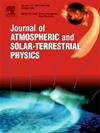Understanding the performance of global precipitation products for hydrological modeling in the data-scarce morphologically complex central Himalayan region
IF 1.9
4区 地球科学
Q3 GEOCHEMISTRY & GEOPHYSICS
Journal of Atmospheric and Solar-Terrestrial Physics
Pub Date : 2025-04-15
DOI:10.1016/j.jastp.2025.106513
引用次数: 0
Abstract
Developing a hydrological model is challenging in ungauged river basins. Hydrological modeling requires historical precipitation estimates. Global precipitation products (GPPs) have equipped hydrologists with a significant resource for hydrological applications such as flood modeling and forecasting. This study compares the quality and hydrological utility of different GPPs, TRMM 3B42, TRMM 3B42RT, APHRODITE, and SM2RAIN in the Gandak river basin (Nepal and India). The study reveals that among the four GPPs, the SM2RAIN had the least average Root Mean Squared Error (RMSE) of 5.83 mm/day, and TRMM 3B42RT had the highest RMSE of 11 mm/day. When it comes to R-squared, SM2RAIN had the highest value (0.37), and TRMM 3B42 showed the lowest at 0.07. Similarly, Bias for SM2RAIN showed the most negligible average bias, which was −5.34 %, and TRMM 3B42 indicated the highest bias of 28.71 %. POD for SM2RAIN was the highest at 0.83 and the lowest for TRMM RT (0.67). Similarly, when a hydrological model using MIKE 11 NAM model was developed and calibrated with gauge data, TRMM 3B42 (daily), TRMM 3B42RT, and SM2RAIN, the NSE were calculated to be 0.74, 0.62, −0.25 and 0.74 respectively for the calibration period and 0.67, 0.51, 0.42 and 0.5, respectively for the validation period. The TRMM 3B42 RT data sets were not found to be suitable for hydrological modeling in the Gandak river basin as mostly the NSE value was found to be negative. The study reveals that the best-suited product among the four GPPs for hydrological simulations in the central Himalayan region is SM2RAIN, followed by the TRMM 3B42.
了解全球降水产品在数据稀缺、地形复杂的喜马拉雅中部地区水文建模中的表现
在没有测站的河流流域,开发水文模型是一项挑战。水文模型需要历史降水量估算。全球降水产品(GPPs)为水文学家提供了重要的水文应用资源,如洪水建模和预报。本研究比较了甘达克河流域(尼泊尔和印度)不同全球降水产品 TRMM 3B42、TRMM 3B42RT、APHRODITE 和 SM2RAIN 的质量和水文实用性。研究结果表明,在四种 GPP 中,SM2RAIN 的平均均方根误差(RMSE)最小,为 5.83 毫米/天,而 TRMM 3B42RT 的均方根误差最大,为 11 毫米/天。就 R 平方而言,SM2RAIN 的值最高(0.37),TRMM 3B42 的值最低,为 0.07。同样,SM2RAIN 的平均偏差最小,为-5.34%,而 TRMM 3B42 的偏差最大,为 28.71%。SM2RAIN 的 POD 最高,为 0.83,TRMM RT 的 POD 最低(0.67)。同样,当使用 MIKE 11 NAM 模型开发水文模型并利用 TRMM 3B42(日)、TRMM 3B42RT 和 SM2RAIN 的测量数据进行校核时,校核期的 NSE 分别为 0.74、0.62、-0.25 和 0.74,验证期的 NSE 分别为 0.67、0.51、0.42 和 0.5。研究发现,TRMM 3B42 RT 数据集不适合用于甘达克河流域的水文建模,因为大部分 NSE 值为负值。研究表明,在四种全球定位系统中,最适合喜马拉雅中部地区水文模拟的产品是 SM2RAIN,其次是 TRMM 3B42。
本文章由计算机程序翻译,如有差异,请以英文原文为准。
求助全文
约1分钟内获得全文
求助全文
来源期刊

Journal of Atmospheric and Solar-Terrestrial Physics
地学-地球化学与地球物理
CiteScore
4.10
自引率
5.30%
发文量
95
审稿时长
6 months
期刊介绍:
The Journal of Atmospheric and Solar-Terrestrial Physics (JASTP) is an international journal concerned with the inter-disciplinary science of the Earth''s atmospheric and space environment, especially the highly varied and highly variable physical phenomena that occur in this natural laboratory and the processes that couple them.
The journal covers the physical processes operating in the troposphere, stratosphere, mesosphere, thermosphere, ionosphere, magnetosphere, the Sun, interplanetary medium, and heliosphere. Phenomena occurring in other "spheres", solar influences on climate, and supporting laboratory measurements are also considered. The journal deals especially with the coupling between the different regions.
Solar flares, coronal mass ejections, and other energetic events on the Sun create interesting and important perturbations in the near-Earth space environment. The physics of such "space weather" is central to the Journal of Atmospheric and Solar-Terrestrial Physics and the journal welcomes papers that lead in the direction of a predictive understanding of the coupled system. Regarding the upper atmosphere, the subjects of aeronomy, geomagnetism and geoelectricity, auroral phenomena, radio wave propagation, and plasma instabilities, are examples within the broad field of solar-terrestrial physics which emphasise the energy exchange between the solar wind, the magnetospheric and ionospheric plasmas, and the neutral gas. In the lower atmosphere, topics covered range from mesoscale to global scale dynamics, to atmospheric electricity, lightning and its effects, and to anthropogenic changes.
 求助内容:
求助内容: 应助结果提醒方式:
应助结果提醒方式:


